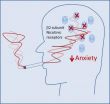(Press-News.org) Deep in the inner ear of mammals is a natural battery — a chamber filled with ions that produces an electrical potential to drive neural signals. In today's issue of the journal Nature Biotechnology, a team of researchers from MIT, the Massachusetts Eye and Ear Infirmary (MEEI) and the Harvard-MIT Division of Health Sciences and Technology (HST) demonstrate for the first time that this battery could power implantable electronic devices without impairing hearing.
The devices could monitor biological activity in the ears of people with hearing or balance impairments, or responses to therapies. Eventually, they might even deliver therapies themselves.
In experiments, Konstantina Stankovic, an otologic surgeon at MEEI, and HST graduate student Andrew Lysaght implanted electrodes in the biological batteries in guinea pigs' ears. Attached to the electrodes were low-power electronic devices developed by MIT's Microsystems Technology Laboratories (MTL). After the implantation, the guinea pigs responded normally to hearing tests, and the devices were able to wirelessly transmit data about the chemical conditions of the ear to an external receiver.
"In the past, people have thought that the space where the high potential is located is inaccessible for implantable devices, because potentially it's very dangerous if you encroach on it," Stankovic says. "We have known for 60 years that this battery exists and that it's really important for normal hearing, but nobody has attempted to use this battery to power useful electronics."
The ear converts a mechanical force — the vibration of the eardrum — into an electrochemical signal that can be processed by the brain; the biological battery is the source of that signal's current. Located in the part of the ear called the cochlea, the battery chamber is divided by a membrane, some of whose cells are specialized to pump ions. An imbalance of potassium and sodium ions on opposite sides of the membrane, together with the particular arrangement of the pumps, creates an electrical voltage.
Although the voltage is the highest in the body (outside of individual cells, at least), it's still very low. Moreover, in order not to disrupt hearing, a device powered by the biological battery can harvest only a small fraction of its power. Low-power chips, however, are precisely the area of expertise of Anantha Chandrakasan's group at MTL.
The MTL researchers — Chandrakasan, who heads MIT's Department of Electrical Engineering and Computer Science; his former graduate student Patrick Mercier, who's now an assistant professor at the University of California at San Diego; and Saurav Bandyopadhyay, a graduate student in Chandrakasan's group — equipped their chip with an ultralow-power radio transmitter: After all, an implantable medical monitor wouldn't be much use if there were no way to retrieve its measurements.
But while the radio is much more efficient than those found in cellphones, it still couldn't run directly on the biological battery. So the MTL chip also includes power-conversion circuitry — like that in the boxy converters at the ends of many electronic devices' power cables — that gradually builds up charge in a capacitor. The voltage of the biological battery fluctuates, but it would take the control circuit somewhere between 40 seconds and four minutes to amass enough charge to power the radio. The frequency of the signal was thus itself an indication of the electrochemical properties of the inner ear.
To reduce its power consumption, the control circuit had to be drastically simplified, but like the radio, it still required a higher voltage than the biological battery could provide. Once the control circuit was up and running, it could drive itself; the problem was getting it up and running.
The MTL researchers solve that problem with a one-time burst of radio waves. "In the very beginning, we need to kick-start it," Chandrakasan says. "Once we do that, we can be self-sustaining. The control runs off the output."
Stankovic, who still maintains an affiliation with HST, and Lysaght implanted electrodes attached to the MTL chip on both sides of the membrane in the biological battery of each guinea pig's ear. In the experiments, the chip itself remained outside the guinea pig's body, but it's small enough to nestle in the cavity of the middle ear.
###The work was funded in part by the Focus Center Research Program, the National Institute on Deafness and Other Communication Disorders, and the Bertarelli Foundation.
Written by Larry Hardesty, MIT News Office
Medical devices powered by the ear itself
2012-11-09
ELSE PRESS RELEASES FROM THIS DATE:
A B C -- 1 2 3, but what is good for me?
2012-11-09
Philadelphia, PA, November 8, 2012 – The National Health and Nutrition Examination Surveys revealed that over 21% of children 2 to 5 years old were considered overweight or obese. Child care settings can serve as a platform to teach children about nutrition in our fight against childhood obesity, as nearly 50% of children in the United States under age 5 are enrolled in child care. In a new study released in the November/December 2012 issue of the Journal of Nutrition Education and Behavior, training child care providers about their role in children's healthful eating ...
Antioxidants may ease PAD blood pressure increase
2012-11-09
HERSHEY, Pa. -- Low antioxidant levels contribute to increased blood pressure during exercise for people with peripheral arterial disease, according to researchers at Penn State Hershey Heart and Vascular Institute.
Peripheral arterial disease, or PAD, affects an estimated 10 million Americans and increases the chance of death from a cardiovascular event. Reduced blood flow causes pain in the legs and increases blood pressure in people who have PAD. However, the causes of the disease are unknown.
"Past studies have shown that having low antioxidant levels and increased ...
Comet collisions every 6 seconds explain 17-year-old stellar mystery
2012-11-09
Every six seconds, for millions of years, comets have been colliding with one another near a star in the constellation Cetus called 49 CETI, which is visible to the naked eye.
Over the past three decades, astronomers have discovered hundreds of dusty disks around stars, but only two — 49 CETI is one — have been found that also have large amounts of gas orbiting them.
Young stars, about a million years old, have a disk of both dust and gas orbiting them, but the gas tends to dissipate within a few million years and almost always within about 10 million years. Yet ...
Is housework a health hazard? Sheet-Fitting palsy described by wake forest baptist physicians
2012-11-09
WINSTON-SALEM, N.C. – Nov. 8, 2012 – What do a tight, fitted bed sheet and a blood clot in the wrist have in common? Both are associated with a condition called sheet fitting palsy. True to its name, the palsy is reported in those who spend a long period of time repeatedly trying to pull a fitted bed sheet over the corner of a mattress. But it has also been reported in basketball players and in those who do push-ups as exercise.
The injury is caused by the continuous flexing movement of the wrist and results in a tiny stroke in the artery to the hand. The resulting ...
More bang for the biofuel buck
2012-11-09
A fermentation technique once used to make cordite, the explosive propellant that replaced gunpowder in bullets and artillery shells, may find an important new use in the production of advanced biofuels. With the addition of a metal catalyst, researchers at the U.S. Department of Energy (DOE)'s Lawrence Berkeley National Laboratory (Berkeley Lab) have shown that the production of acetone, butanol and ethanol from lignocellulosic biomass could be selectively upgraded to the high volume production of gasoline, diesel or jet fuel.
Using the bacterium Clostridium acetobutylicum, ...
Diabetes study: 'Mindful eating' equals traditional education in lowering weight and blood sugar
2012-11-09
COLUMBUS, Ohio – Eating mindfully, or consuming food in response to physical cues of hunger and fullness, is just as effective as adhering to nutrition-based guidelines in reducing weight and blood sugar levels in adults with Type 2 diabetes, a new study suggests.
In a comparison study of the effectiveness of the two types of behavioral interventions, participants lost about the same amount of weight – an average of between 3 1/2 and 6 pounds – and lowered their long-term blood sugar levels significantly after three months.
One treatment group followed an established ...
Taking on the challenges of replication in psychological science
2012-11-09
Psychological science has come of age. But the rights of a mature discipline carry with them responsibilities, among them the responsibility to maximize confidence in our findings through good data practices and replication.
The November issue of Perspectives on Psychological Science, a journal of the Association for Psychological Science (APS), reflects the discipline's ongoing commitment to examine methodological issues that affect all areas of science — such as failures to replicate previous findings and problems of bias and error — with the goal of strengthening our ...
Researchers find why nicotine in cigarettes may relieve anxiety in smokers
2012-11-09
RICHMOND, Va. (Nov. 9, 2012) – Preclinical data suggests inactivation of a specific sub-class of nicotinic receptors may be an effective strategy to help smokers quit without feeling anxious, according to Virginia Commonwealth University researchers.
These findings could one day point researchers to the development of novel therapies to help smokers quit without feeling anxious.
Smokers use cigarettes for many reasons, but many report that they smoke to relieve anxiety, despite the health danger of cigarette smoking. Researchers are now working to understand the underlying ...
Examining transition from student to teacher
2012-11-09
Montreal, November 8, 2012 – "It was the hardest thing I ever had to do, emotionally and mentally." These are not the words we generally associate with a university student who is undergoing teacher training, yet Concordia researcher Anita Sinner has heard similar statements from many such individuals. Every year thousands of students make the transition from student to teacher and the stories of those who struggle are often missing from our conversations.
"Pre-service teachers who experience varying degrees of struggle have few stories against which to compare their ...
When identity is tied to former employer, unemployed report higher well-being
2012-11-09
SAN FRANCISCO, Nov. 1, 2012-- Unemployed workers who continue to identify with their former employer report higher well-being even after being fired or laid off from the company, according to a study published Nov. 9 in the Journal of Managerial Psychology.
The study, conducted by San Francisco State University Assistant Professor of Management Jennifer Tosti-Kharas, is among the first to explore how organizational identification relates to job loss.
"These unemployed people have something to cling to by having had very positive associations with their employer in the ...

